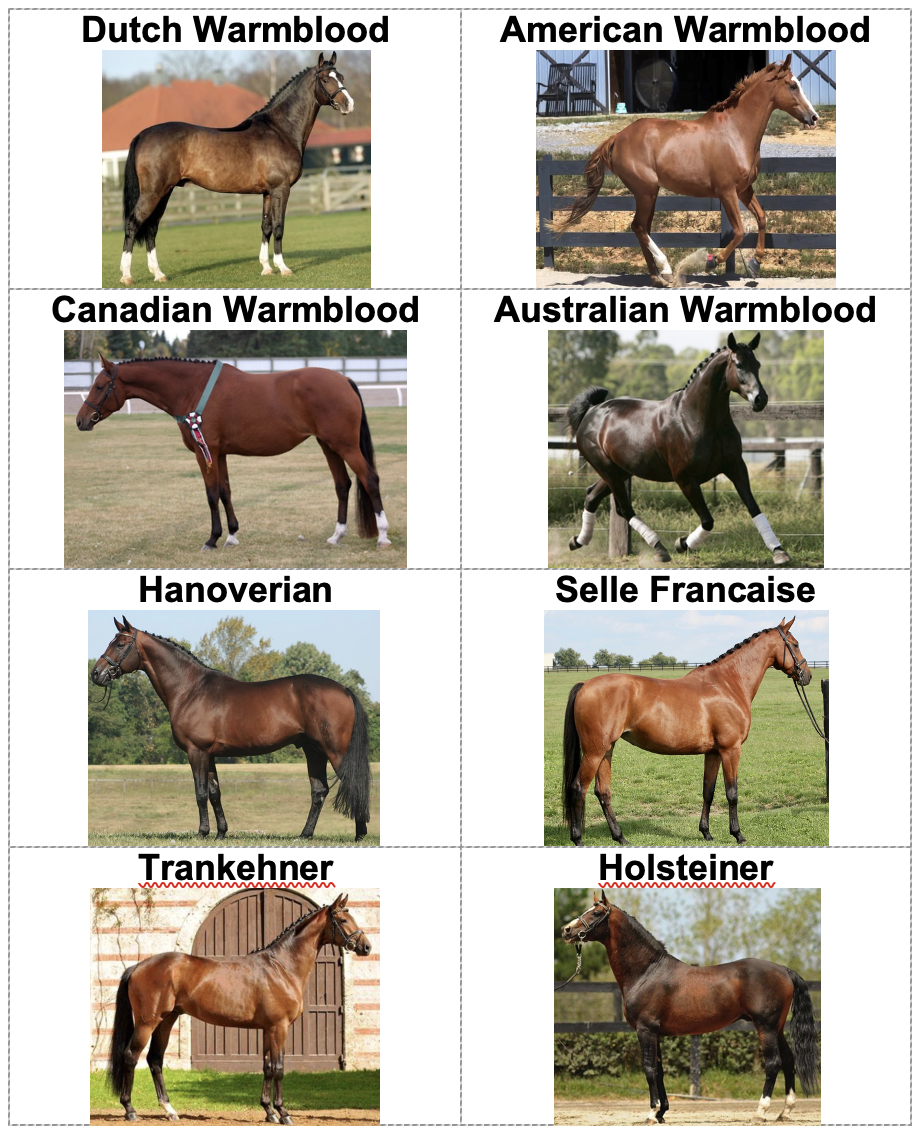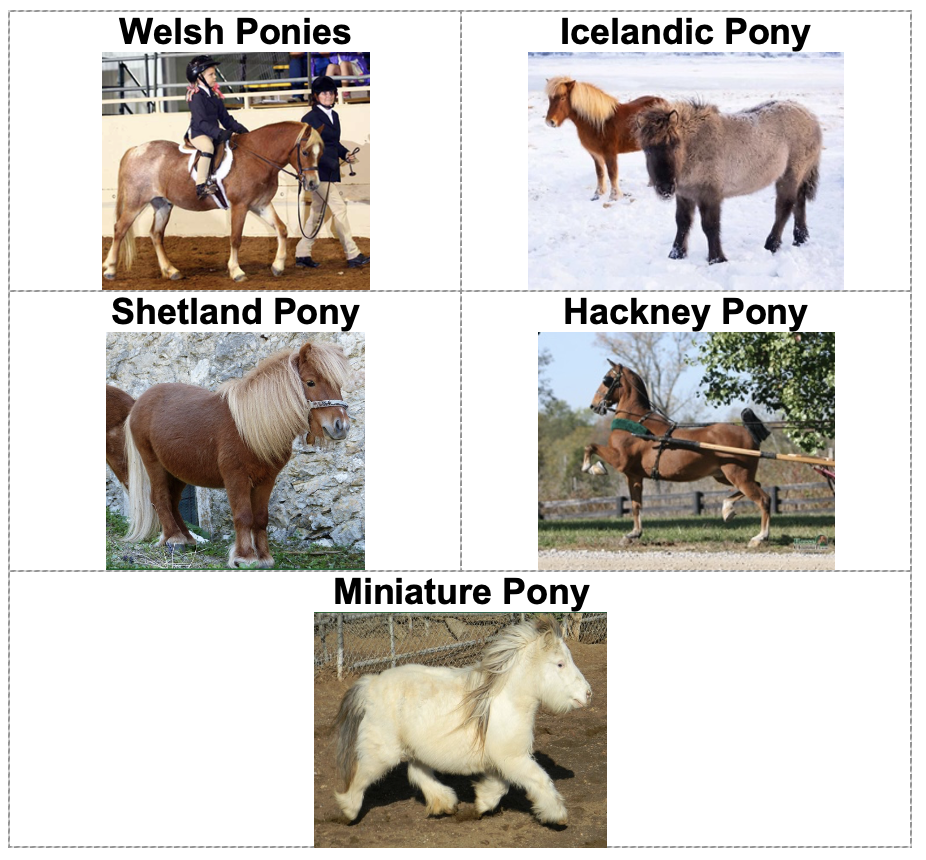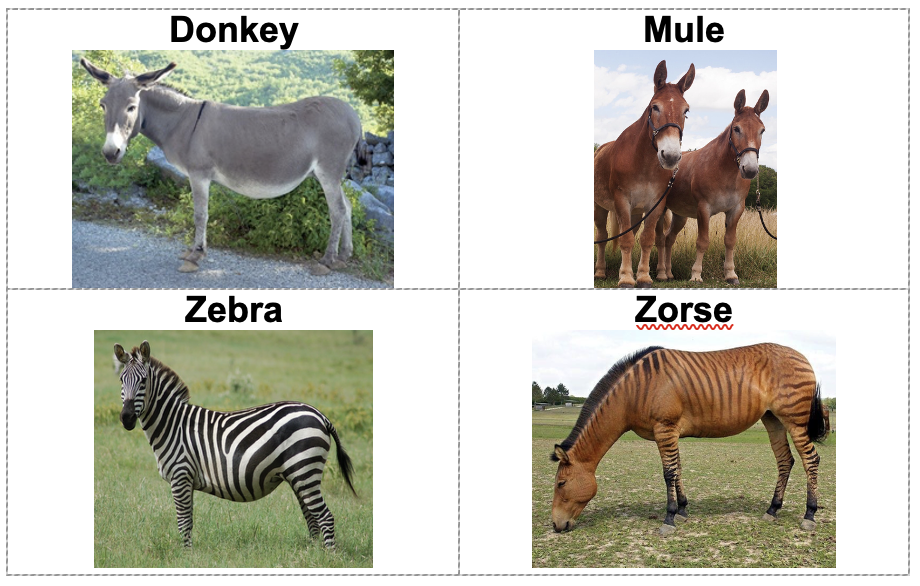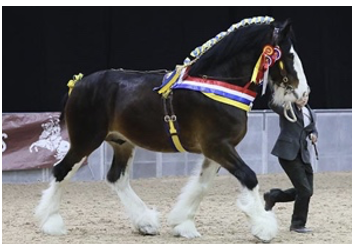Types and Breeds of Horses
1/56
There's no tags or description
Looks like no tags are added yet.
Name | Mastery | Learn | Test | Matching | Spaced |
|---|
No study sessions yet.
57 Terms
Draft horses
Bred to carry and pull heavy loads over twice their weight for short distances
Tall, strong and heavy, weigh over 1600 lbs. and stand over 16 hands tall
Freight hauling to carrying armored soldiers, they were the trucking industry, tractors and heavy haulers of the pre-modern age
Calm, even temperament and level-headed attitude (cold blood)
Examples are Percheron, Suffolk, Belgian, Shire, and Clydesdale (made famous by Budweiser Anheuser Busch)
Tails and mane are tied to prevent them from getting in the way of their work
Feathering
Hair found on legs of the horse
Hairs are thick to keep them warm in temperate climates
Examples of draft horses

Light horses
Bred for speed, agility, endurance, and riding
Used for every form of riding, from pleasure riding, to racing and ranch work
Very greatly in height, weight, build, and color
Bred to be used under saddle
Examples are American Quarter horse, Rocky Mountain horse, Pintos, Polo ponies, and Morgans
Some light horses conserved hot blood as well
High energy, easily excitable, and fleet footed
Examples are Arabians, Andalusians, and Thoroughbreds
Examples of light horses

Gaited horses
Light horses bred for riding but best known for their exceptionally smooth ride
Three gaits walk, trot, and gallop
Plus, pace, running walk, fox trot, rack, and slow gait
Gentleman’s horse
Used for generals, officers, plantation owners, and men of wealth
Prized for their show ring flair and smooth pleasure riding on the trail
Examples of gaited horses

Warmblood horses
Middle weight horses created by cross of cold blood draft horse and a hot blood light horse
Resulted in best of both worlds
Tall, strong, athletic horse with sensible attitude, and plenty of get-up-and-go
Dominate dressage, jumping, harness and equestrian Olympic sports
Examples are Duch Warmblood, Hanoverian, Selle Francaise, Trakehner, Holsteiner
Examples of warmblood horses

Ponies
Horse that measures less than 14.2 hands
14 in Australia
Incredibly versatile horses
Bred to do virtually everything imaginable
Used for pulling, packing, harness, jumping, plowing, and even ranch work
Examples Welsh Mountain Pony, Icelandic Pony, Shetland Pony, Hackney Pony
Examples of ponies

Non-horse types of equine
Related to horses and can be interbred with horses but are not horses themselves
Examples are donkeys, zebras, and mules
Wild ass is untamed version of domesticated donkey
Pound for pound donkeys are much stronger than horses
Original beasts of burden
Sturdy, sure-footed, easy to keep
Mule is cross between horse and donkey
Very strong, agile animal
They are pack animals used to pull freight
Growing popularity as riding animals
A male donkey is a jack, a female is a jennet
Asses are commonly known as donkeys, burros, or jackstock
Zebras are wild, non-domesticated equine
Difficult to train for riding under saddle
Zebra-horse cross is a zorse
Sterile like a mule
Examples of non-horse types of equine

Breed
Common origin
Possess certain well-fixed, distinctive, uniformly, transmitted characteristics no common to other horses
Height
Measured in hands
Hand = 4 inches
Taken from top of withers to the ground
Appaloosa
Light horse breed
Descended from Central Asia
Origin
Idaho, Oregon, and Washington
First bred by Nez Perce Indians
Color
Variations and combinations of colors and spots
Four distinguishable characteristics
Coat pattern
Mottled skin
Speckled and blotchy pattern of pigmented and non-pigmented skin
White sclera
Area of the eye which encircles the iris
Striped hooves
14 to 15.2 hands
Uses
Stock, pleasure, race, parade, hunters, jumpers
Appaloosa

Arabians
Light horse breed
Dish face
Most distinguishable characteristic
Uses
Saddle, show, stock, pleasure, racing, endurance races, completive trail rides
Origin
Saudi Arabia
Color
Bay, gray, chestnut, some white and black
White marks common on head and legs
Arabians

Palomino
Light horse breed
Origin
United States
Spanish descent
Color
Golden with light colored mane and tail
No more than 15% dark or chestnut hair in either main or tail
14.2 to 16 hands
Type desired depends upon intended use
Uses
Parade, stock, pleasure, saddle, fine harness
Palomino

Quarter horse
Light horse breed
Origin
United States
Texas, Oklahoma, New Mexico, Colorado, Kansas
Color
Gray, black, bay, sorrel, chestnut, brown, buckskin, palomino, dun, grullo, red dun, blue roan, and red roan
15 to 16 hands
Well-muscled
Powerfully build
Most versatile of all breeds
First breed native of United States
Uses
Stock, racing, pleasure, hunting, jumping
Quarter horse

Miniature horse
Pony
Origin
England
Color
Any color, marking patterns, or eye color
Height
No more than 34 inches
Uses
Pets, shows
First used to pull ore carts in coal mines
Miniature horse

Shetland ponies
Pony
Origin
Shetland Isles, Scotland
Color
Any color, solid, or mixed
Height classes
Under 43 inches
43 – 46 inches
Long, shaggy outer coat during winter
Full mane and tail
One of the oldest breeds in existence
Uses
Children, harness, racing, roadster
Shetland ponies

Belgian
Draft breed
Origin
Belgium
Color
Chestnut, sorrel, some roans and bays
15.2 to 17 hands
Size
Known for draftiness
Widest body
Most compact, massive
Lowest set draft breed
Uses
Exhibition, special attractions, farm work
Belgian

Clydesdale
Draft breed
Origin
Scotland
Color
Bay, some black, brown, chestnut, and roan
4 white socks
Well-defined blaze or bald face
Size
Medium draft breed
16.2 to 18 hands
Superior style and action
Heavy feathering of feet
Fringe of hair
Uses
Exhibition, special attractions, farm work
Clydesdale

Percheron
Draft breed
Origin
France
Color
Most common
Black and gray
Some
Chestnut and roan
Size
Intermediate
Between Clydesdale and Belgian
16.2 to 17.3 hands
Extremely docile
Clean-cut head
Uses
Exhibition purposes, special attractions, farm work
Mated with Thoroughbreds
Produce hunters and jumpers
Percheron

Shire
Draft breed
Origin
England
Color
Black, brown, gray, chestnut/sorrel
Undesirable
Excessive white markings, roaning
Size
Large
Matched in weight only by Belgian
16.2 to 17.1 hands
War horses in the 15th and 16th centuries
Uses
Exhibition purposes, special attractions, farm work
Shire

Color breeds
Any type or breed of horses accepted for registration with the color as the only requirement or primary criterion
Unlike true breeds, they have few is any unique physical characteristics
The color does not always breed true
Palomino
Golden horse with light-colored flaxen mane and tail
Chestnut horse that has one cream dilution gene that turns the horse into golden, yellow, or tan
Palomino

Pinto
A mixture of white and colored areas on their bodies
Piebald
Skewbald
Piebald
White and black spotting pattern
Piebald

Skewbald
White and any color other than black
White with two other colors which may include black
Skewbald

Categories of painted horses
Tobiano
Overo
Tovero
Tobiano
Most common
White splotches across their back
Tobiano

Overo
White extends from belly and legs upward towards the back
But does not cross the back
Have a “war bonnet” or white face
Overo

Tovero
Combination of Tobiano and Overo
Tovero

Appaloosa
Color breed / color preference
True breed
Leopard
Snowflake
Blanket
Leopard
White with dark spots all over the body
Leopard

Snowflake
Dark horse with tiny white spots
Snowflake

Blanket
Best known pattern
White blanket with dark spots on the rump
Blanket

Characteristics of appaloosa
Striped hooves
Unpigmented sclera
Mottling of skin around nostrils, muzzles, and genitalia
Color pattern